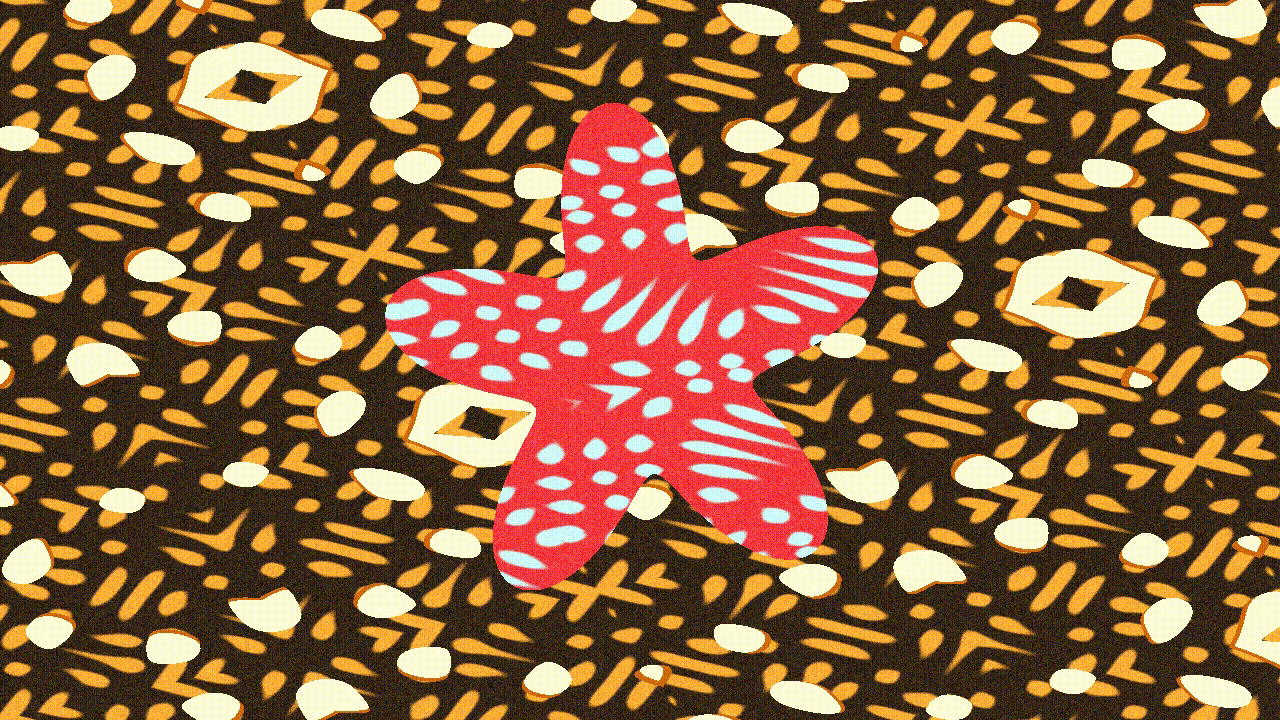
Introduction
This project explores the generative expression of Batik, a traditional Indonesian textile art, through GLSL shaders. By using noise functions, trigonometric patterns, and domain warping, the shader recreates floral and geometric motifs that resemble Batik designs in a dynamic, procedural form.
Technical Approach
Base Functions
- A rotation matrix (
rmatrix) and hash-based noise (hash12) provide randomized yet structured variations in the patterns. - Fractal Brownian Motion (fbm) adds roughness and organic texture to avoid flat, uniform surfaces.
- The movement paired with the noise creates the illusion of rough texture similarly found in Cloth.
- A rotation matrix (
Motifs and Patterns
pattern()generates repeating sinusoidal motifs, forming floral-like tessellations.trigFlower()uses polar coordinates and trigonometric modulation to create radial flower-like forms, echoing Batik’s botanical elements.- Batik Floral pattern mimics the style of Sekar Jagad , but less abstracted.
Color Palettes
batikBgTex()blends deep indigos, warm browns, and creamy yellows—colors historically used in Batik dyeing.batikMaskTex()introduces contrasting highlights, reminiscent of wax-resist dyeing, where wax masks create sharp, layered contrasts.
Dynamic Motion
- Subtle rotation (
rmatrix) and animated offsets ensure that the patterns feel alive, much like the rhythmic flow of Batik-making as wax and dye interact over cloth. - Trying to visualize the relaxing and repetitive nature of creating Batik but also capturing the intricacy.
- Subtle rotation (
Cultural Significance
Batik is not only an art form but also a cultural heritage recognized by UNESCO. By translating Batik patterns into real-time shader code, this project shows how computational art can act as a new medium of cultural expression.
Unlike static fabric, the shader captures Batik’s spirit in a living, digital canvas—patterns morph, colors shift, and textures evolve over time. This generative approach pays homage to Batik’s philosophy: balance between structure and improvisation, symmetry and imperfection.
Conclusion
This shader is more than a technical exercise—it’s an experiment in preserving and reimagining traditional art forms in the context of digital media. By embedding Batik’s motifs into GLSL, it bridges the past and future, celebrating cultural identity through computational creativity.
mat2 rmatrix(float a)
{
float c = cos(a);
float s = sin(a);
return mat2(c, -s, s, c);
}
float hash12(vec2 uv) {
return fract(sin(dot(uv, vec2(12.9898, 78.233))) * 43758.5453);
}
float fbm(vec2 uv) {
float value = 0.0;
float scale = 0.5;
for (int i = 0; i < 5; i++) {
value += scale * hash12(uv);
uv *= 2.0;
scale *= 0.5;
}
return value;
}
float pattern(vec2 uv, float sz, float pts) {
uv *= sz;
uv += vec2(sin(uv.y * 3.0 + iTime * 0.4) * 0.3, cos(uv.x * 3.0 + iTime * 0.4) * 0.3);
float petal = sin(uv.x * pts) * cos(uv.y * pts);
return smoothstep(0.2, 0.6, petal);
}
float trigFlower(vec2 uv, float petals) {
return 1.0 - smoothstep(cos(atan(uv.y, uv.x) * petals) * 0.1 + 0.25,
cos(atan(uv.y, uv.x) * petals) * 0.1 + 0.25 + 0.05,
length(uv));
}
vec3 batikBgTex(vec2 uv, float cn) {
vec3 colors[4] = vec3[4]( vec3(0.011, 0.019, 0.062),
vec3(0.847, 0.556, 0.188),
vec3(0.996, 1.0, 0.780),
vec3(0.752, 0.376, 0.054)
);
float pt6 = pattern(uv, 8.0, 6.0); // Base Pattern
float pt5 = pattern(uv, 4.0, 5.0); // Floral Pattern
float pt52 = pattern(uv, 4.1, 5.0);
vec3 col = mix(colors[0], colors[1], pt6 + cn * 0.5);
if (pt52 >= 0.99) {
col = mix(colors[0], colors[3], pt52 + cn * 0.2);
}
if (pt5 >= 0.99) {
col = mix(colors[0], colors[2], pt5 + cn * 0.2);
}
return col;
}
vec3 batikMaskTex(vec2 uv, float cn) {
vec3 colors[2] = vec3[2]( vec3(1.0, 0.019, 0.062),
vec3(0.847, 0.847, 0.847)
);
float pt6 = pattern(uv, 4.0, 12.0); // Base Pattern
vec3 col = mix(colors[0], colors[1], pt6 + cn * 0.5);
return col;
}
void mainImage( out vec4 fragColor, in vec2 fragCoord )
{
vec2 uv = fragCoord/iResolution.xy;
vec2 uvn = (fragCoord.xy - iResolution.xy * 0.5) / iResolution.y;
float cn = fbm(uvn * 16.0); // Fixed noise for Rough Texture
uv *= rmatrix(sin(iTime / 16.0) * 0.5);
uv = abs(fract(uv * 2.0) - 0.5);
float tf = trigFlower(uvn * rmatrix(-iTime / 16.0), 5.0);
vec3 bgt = (tf < 0.9) ? batikBgTex(uv, cn) : batikMaskTex(uv, cn);
// Output to screen
fragColor = vec4(vec3(bgt),1.0);
}